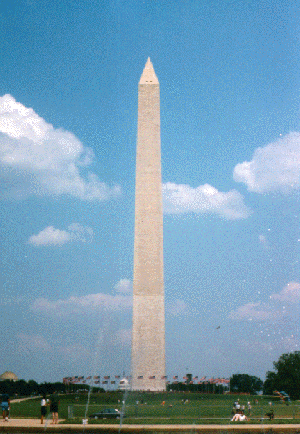
SPRING 1999
ISO THE VERNAL EQUINOX


At the subway stop, we started making weather observations of the day --- observations that would be continued hourly, and compiled with earlier ones that Mike had taken. These included data points for time, ultraviolet (UV) ratings, temperature and notation of cloud cover and types.
At the same time, we noted wind directions and speeds, estimating these by a variety of methods: flags blowing; direction of steam coming up from a vent; trees moving in the wind; clothing on people; hair. We also discussed how one could estimate the time of day by observing the sunís location.
From here, we walked to the Washington Monument, where we made some shadow observations, and discussed how you can tell the times of dayÖ and the seasons of the yearÖ by observing the locations of shadows. As the start of a "documented" observation, we traced the shadow of class member Brad Banks on the Monument sidewalk at about 11:30 AM. We would come back later and do a repeat outline and compare the placement and sizes of the two shadows.
We also learned how to estimate the size of an object, by making a ratio between the shadows of two items, one of which you knew the height. (Students were going to do this with the Monument, but because of current renovating construction, they could not. They did a similar comparison with a site on campus.)
From the current Washington Monument, we walked down its grassy knob to a lower point on the premises and found the original Washington Monument, a small worn granite obelisk. Mike explained to us that this location had at one point been covered by floods from the Potomac River, and that folks decided this might not be a good place for a monument. Also, it was not in a direct line with the Lincoln Memorial and the Capitol, which was part of the overall design for the Mall. The current Monument is built atop a massive landfill.
From here we progressed to the corner of Constitution Avenue and 15th Street. The class broke into four groups, and each group took a corner of the intersection to make a count of vehicles, based on types of vehicle and the number of passengers in them. From this, we got an appreciation for the amounts of pollution caused by automobiles, and the need for car pooling.
Also on each of these corners were granite gateposts which were built in the 1800s. We observed the amounts of erosion on their carved surfaces, caused by weather and pollution. The colors of the faces were also noted. Mike again reminded us that this area had at one time been marshy, and that the areas had been filled. We decided that this wasnít a very comforting thought --- that this very busy intersection of Washington was built on top of a marsh!
We walked a few blocks north. Along the way, we looked at the conditions of trees planted along the sidewalks. Some trees were alive, but many were dead, because they did not have enough space for their roots to spread. Because this root growth tends to be shallow, strong winds and other storms tend to uproot the trees easily. We talked for awhile about the pros and cons of trying to make a city like a park.
We came to an intersection where the street ran east/west, with buildings on the north and south. This represented an "urban corridor", where the sun doesnít reach the south side because of the heights of the buildings, etc. We discussed how the building on the south side didnít get sun at all, whereas the buildings on the north did get some sun during the middle of the day. We discussed how this might affect energy consumption in heating and cooling the buildings, and why plant could not live on the south side of the street.
Our day came to a close by a return tio the Washington Monument where we once again traced Bradís shadow at about 2:30 PM: it had lengthened considerably, and shifted counterclockwise. We discussed why this happens (the sun moves lower in the sky the further it is past noon, therefore casting a longer shadow) and when we would see the shortest shadows (around June 21-22) and when we would see the longest ones (December 21-22).
The class then dispersed to enjoy the rest of this beautiful afternoon in our nationís capital. The area was full of people enjoying the 50-60 F weather by running, flying kites, playing soccer and generally just enjoying the sunny, cloudless day.
The class met on this bright morning and road the subway to the Smithsonian station. There we met with Mike Mogil, who took the class on a tour of Washington DC that they had never seen before. This was the day of the vernal equinox, which officially was to arrive that evening --- the day at our latitude when day and night are of equal length.
 Click here to go to the Spring 1999 Page!
Click here to go to the Spring 1999 Page!